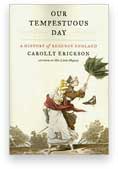Our Tempestuous Day:
 Our Tempestuous Day: A History of Regency England by Carolly Erickson is a great breezy read (appropriate considering the cover), dropping you right onto the streets through people like Louis Simond, an American businessman arriving in Falmouth in the last days of 1809, or putting you beside the sick bed of poor old King George III, fluctuating from lucidity to madness, or marching with General Ludd, or celebrating the victory of Waterloo.
Our Tempestuous Day: A History of Regency England by Carolly Erickson is a great breezy read (appropriate considering the cover), dropping you right onto the streets through people like Louis Simond, an American businessman arriving in Falmouth in the last days of 1809, or putting you beside the sick bed of poor old King George III, fluctuating from lucidity to madness, or marching with General Ludd, or celebrating the victory of Waterloo.
Other characters like Byron and Wellington get their own chapters and over it all, of course, hangs the spectre of Napoleon to explain why all those red coats and naval captains abound in Jane Austen (who apart from mentioning her famous distaste of the Prince Regent gets little mention in the book).
You can almost hear the air being let out of the ballon after Waterloo, of course, especially in the execution of John Cashman, a recently discharged sailor caught up in a riot and found inside a smashed gunshop. The disquiet grows like the English summer riots of 2011 but never completely boils over. No one likes the Prince Regent, but he is some tenuous connection to the still popular George III, despite his madness. The Regent’s wife, Queen Caroline, for some reason remains popular — championed even by Jane Austen — despite her own debauchery, abandonment of Britain and famous divorce trial. It’s all a matter of impressions that are not quite right, just like the Regent’s belief in his own wartime glories, displayed in the medals he wore for battles never fought.
The book ends with the sadness of the Peterloo Massacre amid the exhortations of Henry “Orator” Hunt, an M.P. who announced a political meeting in St. Peter’s Fields in Manchester in 1819. It was classic tragedy where protestors and the horsemen of the Manchester Yeomanry stood opposed amid banners and cries opposing the Corn Laws or espousing universal suffrage; and who knows why the bugle sounded. It all ended with eleven dead and hundreds wounded.
The coda of the book is, of course, the death of King George III, the end of the Regency and the installation of George IV, too ill from anxiety and his dissipated lifestyle to attend his own procession at Windsor Castle.


